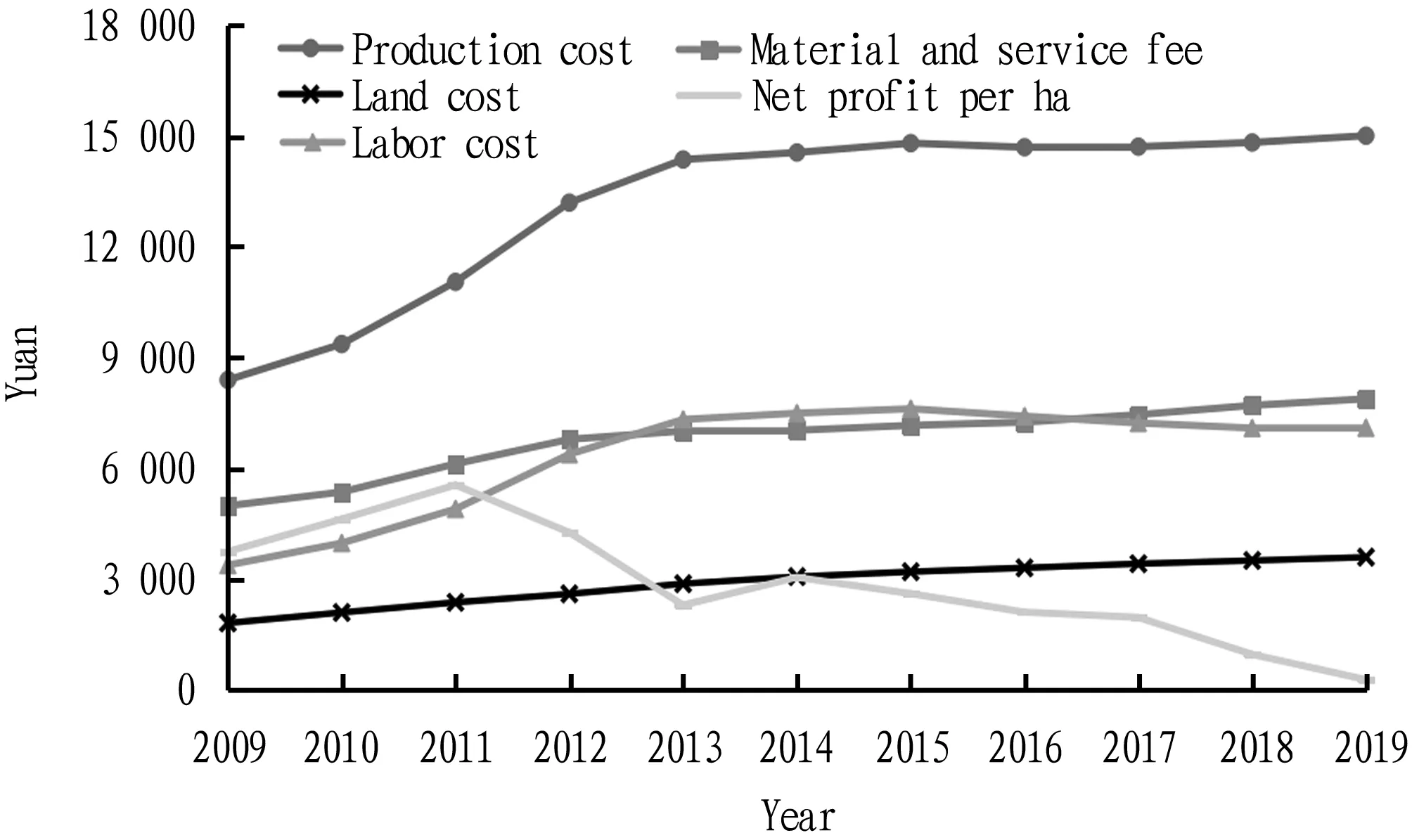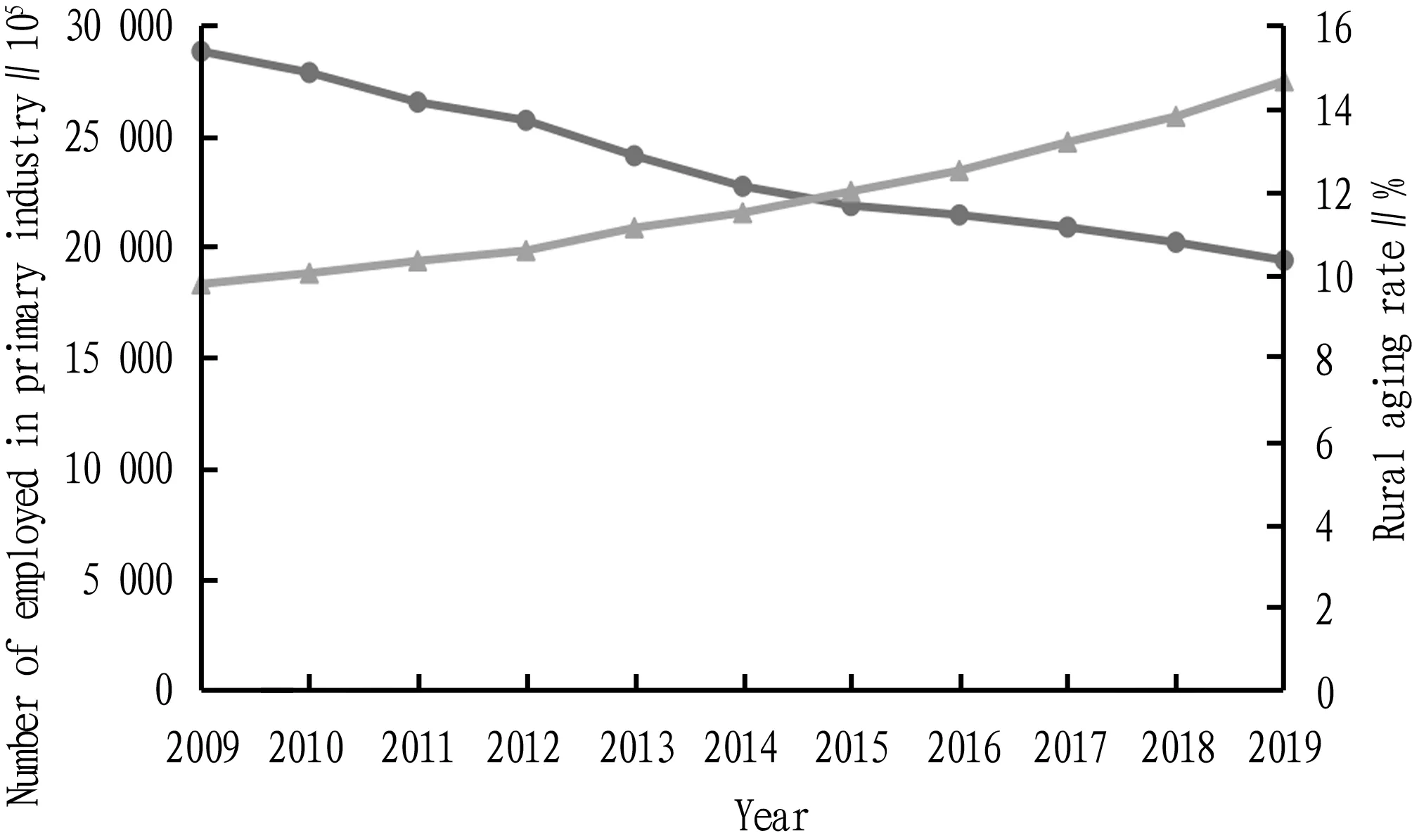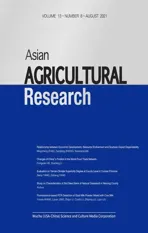Changing Trend and Influencing Factors of Rice Production Cost in China
2021-10-21XinyuLUO
Xinyu LUO
School of Economics and Management, Yangtze University, Jingzhou 434023, China
Abstract Rice is one of the three major food crops in China. The change of its production cost is related to food security and farmers’ income in China. This paper analyzes the changing trend of rice production cost in China from 2009 to 2019, analyzes the factors leading to the change from the aspects of land scale, labor force structure, agricultural science and technology level, etc. On this basis, this paper puts forward measures and suggestions to reduce rice production cost and improve farmers’ income.
Key words Rice, Production cost, Scale operation, Mechanization
1 Introduction
Food security has always been an important social issue related to national economy and people’s livelihood. Ensuring food security has always been the basic goal of China’s agricultural policy. Since the 18National Congress of the Communist Party of China, General Secretary Xi Jinping has made it clear that solving the problem of food is the top priority of government. The 14Five-Year Plan and 2035 Vision also include increasing overall food production capacity as a mandatory target. As one of the three main food crops in China, rice plays a pivotal role in China’s food security. In recent years, the price of rice in the international market has fallen, and China is slightly weak in the competition of rice in the international market. From 2016 to 2019, the average net income per unit area of rice crops in China was negative continuously. Only by studying and analyzing the reasons for the decline of grain planting income in China and proposing measures can we fundamentally improve the domestic grain competitiveness and guarantee food security. One of the important reasons for the lack of competitiveness of Chinese rice in the international market is the high production cost. Therefore, based on the relevant data from 2009 to 2019, this paper analyzes the changing trend and influencing factors of Chinese rice production cost and puts forward some relevant suggestions.
2 Composition and changing trend of rice production cost
2.1 Composition of rice production cost
According toCompilation
of
Cost
and
Benefit
Data
of
Agricultural
Products
(2020
) published by the National Development and Reform Commission, the total cost of rice cultivation is composed of agricultural production cost and land cost, in which the production cost is mainly composed of material, service costs and labor cost. Material and service fees refer to the maintenance costs and indirect management costs related to rice in the process of planting, labor costs refer to the costs converted from labor costs, and land costs refer to the costs of acquiring the planting land used for rice.
Data source: Compilation of Cost and Benefit Information of Agricultural Products (2020).

Data source: EPS database.
According to the data of 2019, rice production cost accounted for 80.58% of the total cost, while land cost only accounted for 19.42% of the total cost, that is, production cost was the most important expenditure in the process of rice planting. Among them, labor cost accounted for 47.39% of the production cost, and the cost of seeds, fertilizers, pesticides, machinery and other agricultural materials accounted for 50.36% of the production cost. It can be seen that the main cost in the rice production process comes from labor cost and material cost. With the increase of agricultural materials and labor cost (pesticide and fertilizer,etc.
), it brings a great burden to farmers and reduces their planting enthusiasm.2.2 Changing trend of rice planting cost
According to the trend of change in the past decade, under the guidance of the government’s preferential policy of supporting grain cultivation and ensuring grain supply, the national rice sown area has been on the rise from 29 793 thousand ha in 2009, but began to decline significantly after reaching 30 747 thousand ha in 2017. The total sown area of rice in 2019 was 29 694 million ha, even lower than the level in 2009. Under the minimum grain purchase price policy implemented by the state to ensure food security, the decrease of farmers’ enthusiasm for rice planting is closely related to the increasing cost of rice planting. According to the data, the cost of rice cultivation in China has been increasing year by year, with the average total cost per ha of rice growing from 10 246.8 yuan in 2009 to 18 626.55 yuan in 2019, an increase of 81.78%. As shown in Fig.1, the production cost of rice increased rapidly from 2009 to 2013, and has been slowly increasing since 2013. The production cost per ha increased from 8 408.85 yuan to 15 010.2 yuan, with an increase of 78.50%. The cost of land increased slowly from 2009 to 2019, from 1 837.95 to 3 616.5 yuan, an increase of 96.77%. The changing trend of material and service costs and labor costs is similar, with a large increase before 2013 and a small increase from 2013 to 2019. However, labor costs start to decline slowly from 2015, and material and service costs still increase, which may be related to the development of agricultural mechanization level in China. In the process of rice planting, machinery replaces part of the labor force, making the labor cost begin to fall, but the mechanical processing cost begins to rise. However, the average net profit of rice planting in China has been showing a downward trend since 2011, and decreased to 306 yuan/ha in 2019. The continuous decline of income increases the burden of farmers, and is also an important reason for the decrease of farmers’ planting enthusiasm.3 Analysis of influencing factors of rice planting cost
3.1 The scale of land operation
Moderate scale management is the only way for the development of modern agriculture in China. At present, the production and management of small-scale farmers in China can no longer adapt to the development of modern agriculture. Scattered rice planting land will increase the unit cost of rice planting, and dispersion pattern of farmland will be difficult to achieve economies of scale. The farmer’s rice planting field is too fragmented, which will cause the waste of agricultural resources, reduce the labor efficiency, increase the mechanized operation difficulty and so on, leading to inefficient land output. Xu Qing analyzed the field survey data of 1 049 farmers in major grain producing areas in China, and concluded that although expanding the scale of land operation may not bring more grain production, it can reduce the unit production cost of products. Therefore, from this point of view, the expansion of agricultural operation scale is conducive to promoting farmers to increase income. From another point of view, under the condition of existing scale of rice planting, there is a phenomenon of farmland abandonment in most rural planting areas of China. Due to the increased rice planting land costs, there will be large agricultural cooperatives or the grain growers will take moderate scale operation, which can reduce the rate of land abandonment while increasing farm size and average distance from the narrow belt, thereby reducing agricultural production cost.3.2 The structure of rural labor force changes
Rice planting is a kind of labor-intensive agriculture, and the change of rural labor population structure is closely related to the labor cost of rice planting. In recent years, with the development of industrialization and urbanization, a large number of rural labor forces have been transferred to non-agricultural industries, and the number of rural people engaged in the primary industry has decreased year by year, with an average annual decrease of 8.586 4 million, as shown in Fig.2. In addition, rural areas are faced with the problem of population aging, and the rural aging rate is increasing year by year, from 9.80% in 2009 to 14.69% in 2019. Most of the young and middle-aged people in rural areas choose to go out for work, and the surplus elderly population in rural areas is relatively large. The overall quality of the labor force engaged in rice cultivation has declined, and the characteristics of "aging, feminization and scarcity" have become increasingly apparent. With a lack of rural labor force, farmers face the choice of paying too much labor cost or more self-exploitation, labor efficiency is not high, increasing the labor cost of rice cultivation. The loss of agricultural labor force will also cause the replacement of original labor force by fertilizer, pesticide and machinery in rice production, which will lead to the continuous additional use of agricultural chemical inputs and increase material and service costs. To sum up, farmers engaged in agricultural production have the obvious characteristics of lack of quantity and aging, and the structural shortage problem is prominent, which seriously restricts the effective supply of rural labor force, resulting in a long-term trend of rising cost of rice production.3.3 Agricultural science and technology level
With the development of science and technology, rice planting has gradually changed from manual to mechanical. From 2009 to 2019, the total power of agricultural machinery increased by 152.62 billion w, and the level of mechanization was greatly improved. However, in the rice planting process, agricultural mechanization level is far from meeting the requirements of modern agriculture for new technologies, and there is still a problem of low conversion rate of agricultural scientific and technological achievements. The level of improved rice varieties is not high, and there is a lack of good seeds with good quality and high yield, so that farmers can choose varieties with higher income to increase the yield of rice and increase the cost advantage. There is a lack of green, pollution-free, high-fertility fertilizers, which are the key to improving the quality and yield of rice, and green fertilizers can reduce soil pollution, promote the sustainable development of agriculture. Science and technology is the first productive force, and provides the strong backing for the development of modern agriculture. In view of the current rice planting conditions, it is necessary to vigorously develop the level of agricultural science and technology, accelerate the input of machinery, improve labor production efficiency, reduce labor costs and agricultural materials, increase the income of rice planting.4 Conclusions and recommendations
4.1 Improving the agricultural operation system and developing moderate scale of operation
First of all, it is necessary to cultivate the main body of rice scale cultivation and promote scale management. Land fragmentation has the greatest impact on the production cost of rice, which will increase the production cost per unit area. In order to achieve the ideal benefits of large-scale operation, large growers, rural cooperatives, leading agricultural enterprises and other operating entities need to adopt modern production factors and change the operation mode to meet the requirements of professional and standardized development. Next, it is necessary to develop agricultural machinery to serve production vigorously, support the development of professional cooperatives and large growers, reduce the investment constraints and sunk costs caused by the high value and specificity of agricultural machinery, and ease the constraints of capital and technology faced by farmers in the process of scale operation. It is necessary to complete the replacement of machinery to labor in each link of grain production and reduce grain production costs. Finally, the government should strengthen the supervision of land transfer, leasing and large-scale operation. Land rectification efforts should be appropriately intensified, land quality should be correctly evaluated, and land transfer and lease costs should be appropriately regulated. It is necessary to accord with standard of moderate scale of professional investors and local family farms to give key support funds, optimize policy support and process at the same time, avoid direct linkage with land transfer behavior. In addition to land swap, the right to the contracted management of land shall replace the circulation and exit excluding one-off reward, compensation, to avoid directly giving cash subsidies or reward, and prevent the occurrence of "subsidies or incentives transformed into rent".4.2 Cultivating agricultural socialization service organizations and improving the quality of agricultural labor force
Above all, we should build agricultural socialization service organization, and increase rice production socialization service level, to promote coordinated development of grain production scale and service scale, leading the small farmers and modern agricultural organic link, in order to effectively solve the problem of rural labor quantity and quality decline, form appropriate scale operation and capacity, establish a mechanism for linking the interests of scale operators and service institutions, and improve the production efficiency and benefit of the main body of scale operation in rice production. Secondly, various supporting policies should be improved. We will promote land transfer among small farmers and develop land management models such as land trusteeship to free up labor. On the other hand, it is necessary to guide the surplus rural labor force to work in professional cooperatives and family farms, train a number of farming experts, improve labor efficiency, and ensure food production while increasing farmers’ income and social security. Finally, we should improve the government labor subsidy policies. It is necessary to increase subsidies for young and middle-aged rural labor force, encourage young and middle-aged rural labor force to start their own businesses, develop modern agriculture, provide talent support for the construction of a new socialist countryside, strengthen exchanges between universities and farmers, provide one-to-one assistance, and optimize the rational allocation of human resources and economic resources in rural areas. At the same time, we should actively improve the rural social security system, arrange the living security for the rural elderly, provide a favorable development environment for the rural economic development, guarantee the due income of the main body of rice production, and enhance the enthusiasm of farmers to grow grain.
4.3 Vigorously training scientific and technological innovation personnel and working together to promote agricultural scientific and technological innovation
Innovation and application of agricultural science and technology is the fundamental driving force to promote agricultural supply-side structural reform and improve total factor productivity. First of all, we should increase the financial input to agricultural science and technology innovation research and development, optimize the agricultural science and technology innovation environment, focus on improving the diversity and adaptability of the supply of agricultural machinery and tools according to regional differences, industrial characteristics, scale of operation,etc.
, promote the corresponding agricultural machinery, and improve the level of intensive farming to cope with the resource endowment characteristics of more people, less land, scattered operation. It is necessary to improve the grain yield perunit area by means of science and technology, research and development of high-quality rice seeds, while improving the yield and ensuring the quality of rice, to produce high-quality and efficient green fertilizers and pesticides in response to the national double reduction policy and improve the use efficiency of fertilizers and pesticides. Secondly, it is necessary to increase the intensity of science popularization to farmers. After the successful research and development of new varieties and technologies, demonstration fields will be established, and the popularization of science among rice growers will be vigorously promoted through professional cooperatives, large growers and other operating entities, so as to promote the progress of agricultural technologies and ensure the grain output of farmers. Finally, we should cultivate new professional farmers for scientific farming, and we will give full play to the leading role of the government in cultivating new professional farmers and improve their professional production level and overall quality. We will promote the use of green, high-quality and efficient technologies for grain production, promote scientific rice planting and breeding models and better varieties and methods to increase ecological and organic production, actively guide green rice production, and accelerate the transformation and upgrading of green agricultural production.
杂志排行
Asian Agricultural Research的其它文章
- Relationship between Economic Development, Resource Endowment and Soybean Export Dependability
- Fluorescence-based PCR Detection of Goat Milk Powder Mixed with Cow Milk
- Current Situation of Table Grape Industry in Henan Province and Development Recommendations
- Changes of China’s Position in the World Food Trade Network
- Determination of Inorganic Anions and Melamine in Fertilizers by Ion Chromatography
- Evaluation on Terrain-Climate Superiority Degree at County Level in Yunnan Province
